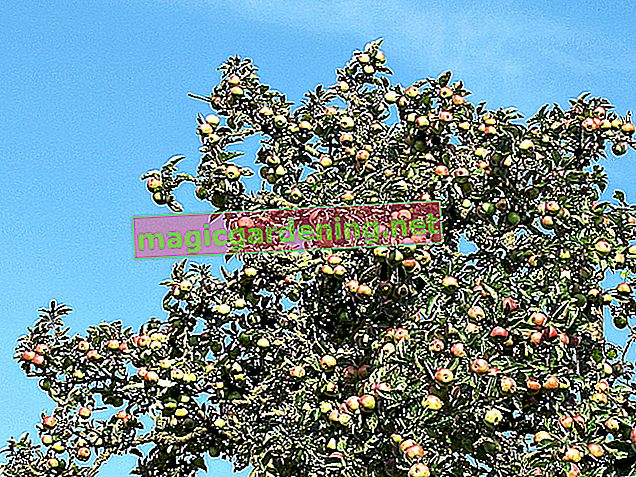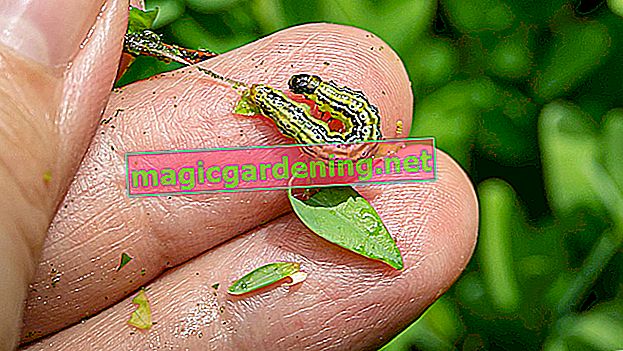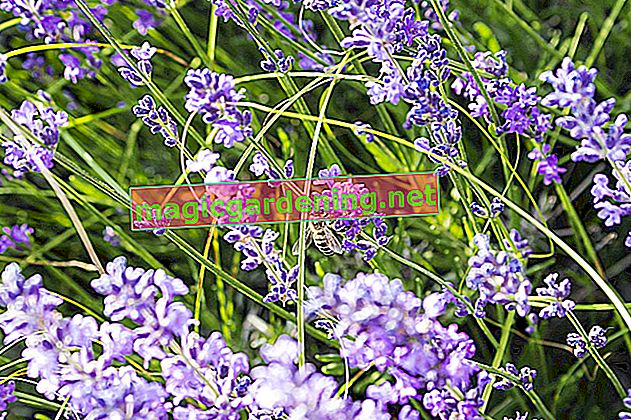
Planting gypsophila correctly
Assign gypsophila to a spot in full sun, dominated by lean, sandy-gravelly soil. The more finely crumbly the soil is prepared, the more vital the fleshy, strong root system develops. If you have concerns about permeability, add fine chippings, gravel or sand to the substrate (€ 12.80 at Amazon *). Compost or other organic soil additives have no place in Gypsophila paniculata. How to properly plant gypsophila:
- Place the still potted root ball in a container with water
- Meanwhile, dig a spacious planting pit
- Create a small mound at the bottom to place the potted root ball on
- Fill up to the lower pair of leaves with substrate, press and pour
also read
- Is there gypsophila perennial?
- When does the gypsophila bloom?
- How to care for gypsophila - the most important tips
The small mound made of coarse-grained substrate effectively prevents waterlogging. In addition, this horticultural trick helps to ensure that permanent winter wetness does not cause root rot.
Continue reading
Care tips
It is astonishing how short the care program resulted in the long flowering period of Gypsophila paniculata. While fertilization is to be avoided entirely, watering can at least be considered in the case of summer drought. Cutting back the faded stems down to the foliage attracts a second cluster of flowers. Cut the veil gypsum to just above the ground in late winter. If you spread a layer of brushwood over the bed when it is wet in winter, this caution will protect the perennial from root rot.
Continue reading
Which location is suitable?
At home in the sun-drenched, dry and hot regions of southern Europe, gypsophila feels particularly at home in the full sun rock garden and gravel bed. The earth should be sandy-gravelly, lean and dry so that the airy flower clouds flourish splendidly. No waterlogging should be seen far and wide, because the magnificent perennial is not made for damp, wet soil.
Continue reading
The correct planting distance
A cleverly chosen plant spacing contributes significantly to the fact that Gypsophila paniculata can spread its airy, light veil of flowers in a harmonious look. We have compiled recommended planting distances for you that are appropriate for the various heights and widths:
- Plant height 10-15 cm and width up to 30 cm results in a plant spacing of 20-30 cm
- Plant height 20-30 cm and width 60-80 cm results in a planting distance of 80 cm
- Plant height 30-40 cm and width 20-30 cm results in a planting distance of 30 cm
- Plant height 80-100 cm and width 40-80 cm results in a planting distance of 50 cm
- Plant height 100-120 cm and width up to 80 cm results in a planting distance of 70 cm
What soil does the plant need?
Wherever the earth is sandy-gravelly, dry, lean and calcareous, Gypsophila paniculata unfolds its delicate flower beauty. The creeping species decorate the crown of a dry stone wall in an inimitable way, while the gypsum herbs soaring skyward give a summer rendezvous in the well-drained soil of the rock garden. For potted plants, we recommend a lean herbal soil as a substrate, to which you add vital lime or rock flour (€ 14.95 at Amazon *) as well as fine grit or sand.
What is the best time to plant?
So that no belated frosts affect the delicate veil of flowers of Gypsophila paniculata, choose a planting time from mid-May. If you prefer autumn as the classic time for perennial planting, you cannot avoid adequate winter protection for the young plants. The effort is rewarded with an early start to flowering next year from mid-April.
When is the flowering time?
If you arrange early flowering species with later flowering gypsophila, the fragrant flower clouds will float through the garden all summer. Low upholstery gypsophila (Gypsophila repens), for example, blooms from May to July, while panicle's gypsophila (Gypsophila paniculata) blooms from June to September.
Continue reading
Cut gypsophila correctly
The key to professional care for Gypsophila paniculata is the right cut. How to handle the subject with expertise:
- Cut off wilted panicles after the first bloom to motivate gypsophila to re-bloom
- The first cut is made to the foliage
- You can either leave the post-bloom to stand for self-sowing or cut off the first pair of leaves
- Do not prune close to the ground until early spring
If you use Gypsophila paniculata as a vase ornament or an accessory to the bouquet, cut the flower stalks in the early morning when two thirds of all the buds have opened.
Continue reading
Watering gypsophila
The additional supply of water is of secondary importance for the growth and abundance of flowers of a Gypsophila paniculata. Only water the gypsophila a little in summer drought. Cultivated in a bucket, there is only a need for watering when the top 5-6 cm of the substrate is dry.
Fertilize gypsophila properly
Gypsophila is one of the rare exceptional plants on which the administration of fertilizer in any form has a counterproductive effect. Even the use of a layer of mulch made of organic materials has negative effects on Gypsophila paniculata, up to and including the complete refusal to flower.
Diseases
If a gypsophila takes care of itself while the base of the stem turns dark at the same time, the plant suffers from a fungal infection. Possible culprits are different types of spores, all of which cause similar symptoms. Dig up the infected perennial widely to prevent it from spreading further in the garden. So that the dilemma does not repeat itself, you should not expose Gypsophila paniculata to waterlogging, keep the soil permeable at all times and do not use nitrogen-rich fertilizers.
Pests
Snails and rabbits like gypsophila to eat. Since you are dealing with two stubborn and ruthless predators of the magnificent perennial, the following precautions are essential:
- Plant Gypsophila paniculata with snail collars in snail-infested areas
- Place walking barriers around the bed or erect a snail fence
- If the infestation pressure is high, set up crack traps with slug pellets (€ 16.78 at Amazon *)
Keep wild rabbits away from the property with a fence made of rabbit wire that extends 30 cm into the ground. In addition, the specialist trade offers special deterrents, which the rabbits run away when used.
Overwinter
Gypsophila paniculata thrives as a completely hardy perennial. While the above-ground parts of the plant are pulled in during the winter, the root ball in the ground survives even the deepest minus temperatures undamaged. The only problem is too much winter wetness, so we recommend covering a large area with brushwood. In the pot there is regularly the risk that the almost unprotected root ball will freeze through. Therefore, wrap the vessels in bubble wrap and place them on wood.
Propagate gypsophila
The busy summer bloomer gives so much joy in the ornamental garden that the desire for more specimens is stimulated. Choose from the following methods of propagation, all of which are straightforward:
- Cut cuttings to allow them to take root in the poor substrate during the summer
- Division of the root ball in spring or autumn
- Sow behind glass from March
Continue reading
How do I transplant properly?
Since Gypsophila paniculata develops a strong, fleshy root system, transplanting the perennial turns out to be risky. If a change of location is unavoidable, choose an appointment in spring. In this way, a sufficiently long period is available for re-rooting until winter. Cut off the side roots in a radius that roughly corresponds to the height of the gypsum herb. As an exception, the plant is watered repeatedly in the new bedding area in order to force the formation of fresh fine roots.
Gypsophila in the pot
With gypsophila in the pot, the sunny balcony is transformed into a sea of white and pink flowers. To enjoy this splendor throughout the summer, use a lean herb or pricking soil as a substrate. Add fine gravel or sand to guarantee the desired permeability. A pottery drainage over the water drain prevents damaging waterlogging. Water Gypsophila paniculata only when it is dry and do not use fertilizer. If you cut the first flower pile down to the foliage, with a little luck a late summer re-bloom will appear. Before the first frost, wrap the pot in foil or take it to a frost-free winter area.
Continue reading
Is gypsophila poisonous?
In small doses, gypsophila has a healing effect aimed at mild discomfort in the throat area. In folk medicine, however, gypsum has long since lost its importance. The saponins contained in Gypsophila paniculata, on the other hand, cause considerable poisoning symptoms in humans and animals in large quantities. Therefore, do not leave small children and pets unattended within reach of gypsophila.
Continue reading
Can gypsophila be dried?
It seems like magic and is rather rare in the flower kingdom, because Gypsophila paniculata hardly loses any of its natural beauty after drying. To preserve the extremely delicate flower panicles for a long time, proceed as follows:
- Cut off the blooming stems when dry
- Remove the leaves at the bottom
- Tie the gypsophila in small bouquets with raffia
Hanging upside down in an airy, dark and rainproof place, the flowers dry within a few days. As the moisture escapes from the stems, gently tighten the binding material. Then keep the gypsophila at room temperature so that it doesn't start to trickle.
Continue reading
Nice varieties
- Bristol Fary: Filigree branched Gypsophila paniculata with white flowers over blue-green foliage; Height 80-100 cm
- Rose veil: soft pink, double spherical florets characterize this very compact variety; Growth height 30-40 cm
- Flamingo: The variety captivates with pink clouds of flowers and a long flowering time until autumn; Growth height up to 120 cm
- Snowflake: Tall gypsophila in a class of its own with white, fragrant flowers; Growth height up to 100 cm
- Compacta Plena: Filled gypsophila in white, ideal for the balcony box thanks to its overhanging growth; Growth height 30 cm








